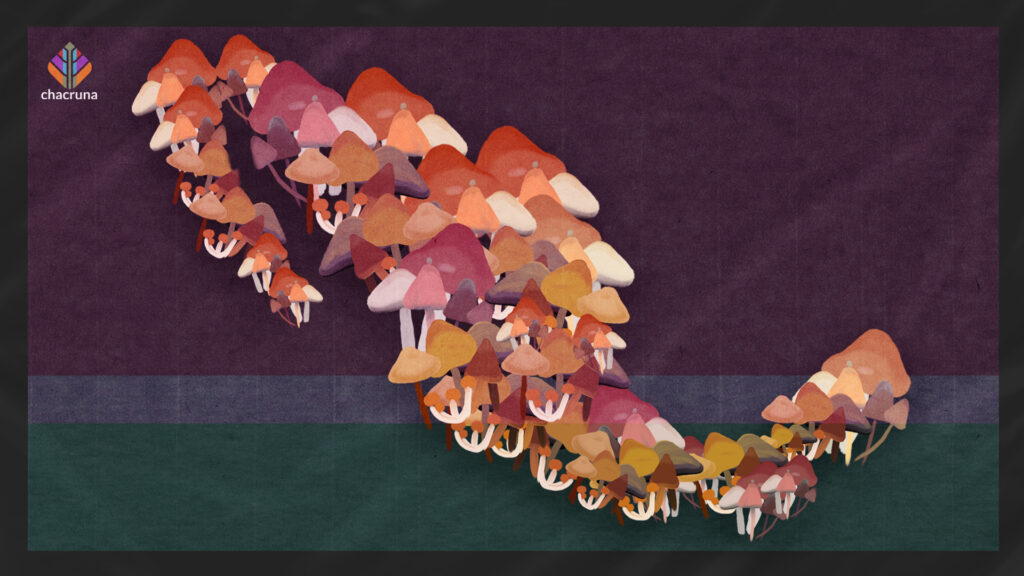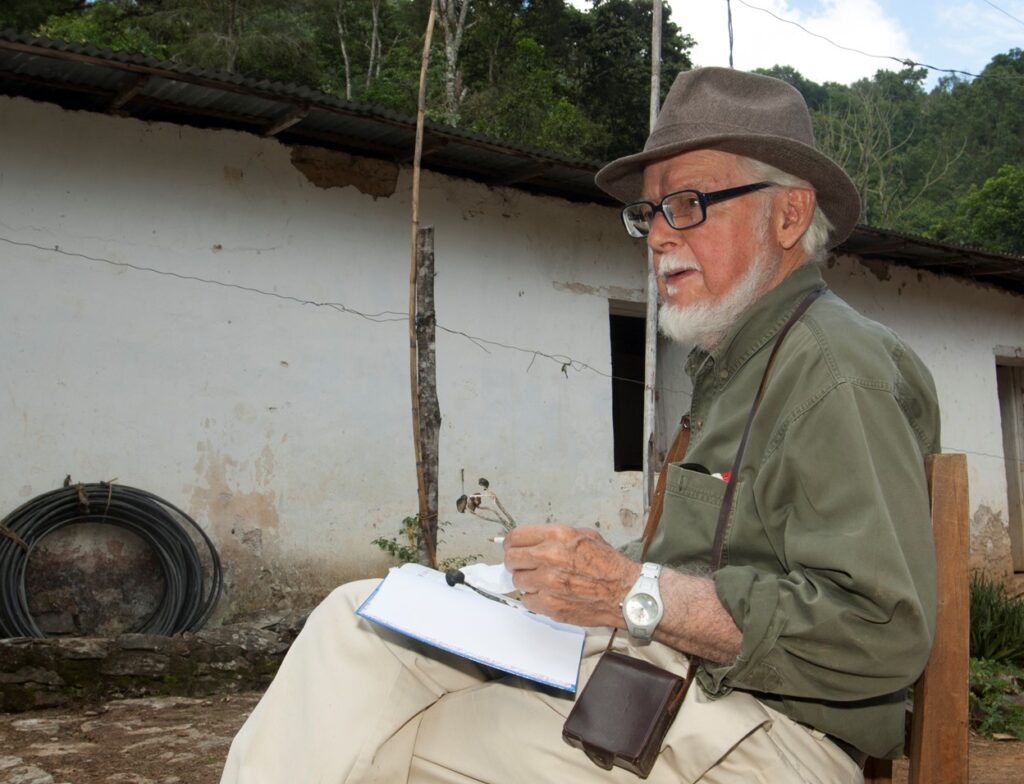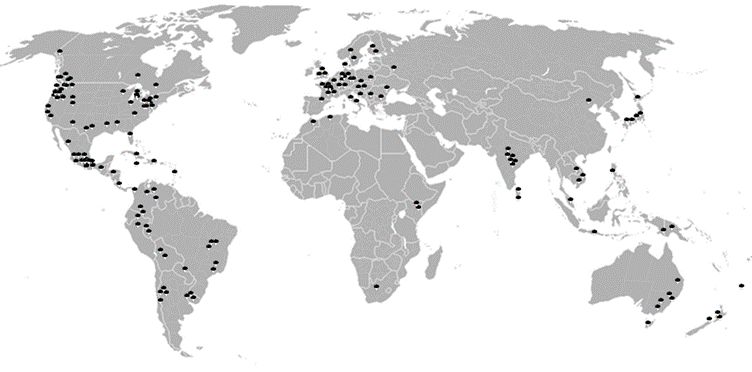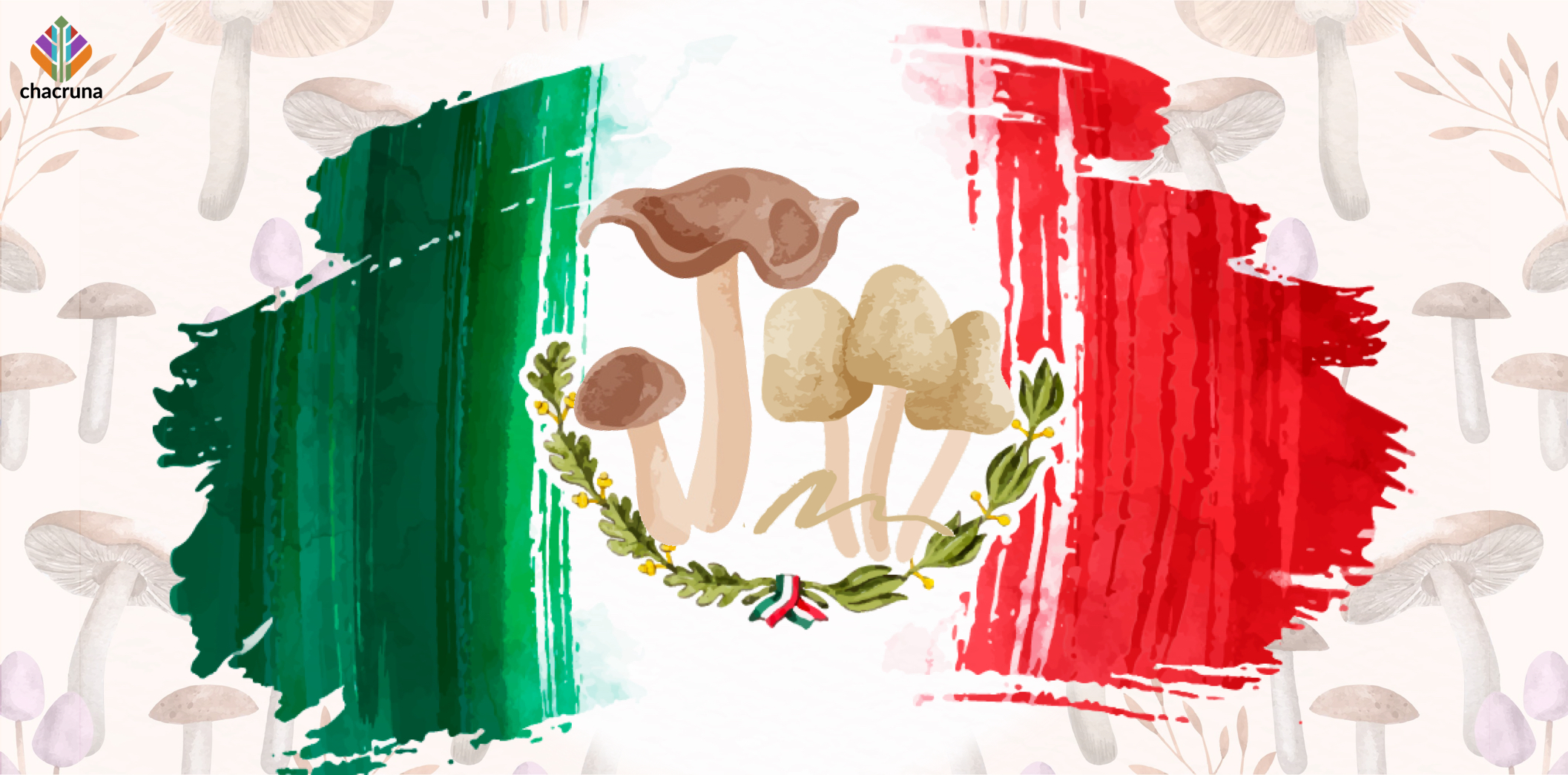No article reviewing the psychoactive mushrooms of Mexico would be complete without emphasizing the life and work of Gastón Guzmán Huerta, an eminent Mexican mycologist and ethnomycologist who dedicated his life to discovering and researching mushrooms of the genus Psilocybe. His contribution to mycology about the hallucinogenic species is enormous—more than half of known psilocybin-containing mushrooms were first discovered and described by Guzmán and his collaborators. He was also a leading authority on the divinatory and medicinal uses of the sacred mushrooms by the Indigenous peoples of Mexico.

Gastón Guzmán Huerta “dedicated his life to discovering and researching mushrooms of the genus Psilocybe.”
Gastón Guzmán was born in Xalapa, Veracruz in 1932, and later moved to Mexico City with his family. There he went to Escuela Nacional de Ciencias Biológicas (ENCB) of the Instituto Politécnico Nacional, where he studied biology. His interest in mycology began in 1956 when he worked for Geigy, a Swiss pharmaceutical company interested in hallucinogenic mushrooms, and continued in 1957 when he worked as an assistant to Rolf Singer—one of the most important mycologists of the 20th century who studied gilled mushrooms (agarics)—who encouraged him to continue his career as a mycologist. While exploring Huautla de Jiménez region of Oaxaca, Mexico, Guzmán met R. Gordon Wasson which led to their life-long friendship. Through Gordon and his wife Valentina Pavlova Wasson, Dr. Guzmán befriended Roger Heim and Richard Evans Schultes. The following year he published his first research article on the ecology of Psilocybe species. In the next 50 years he continued publishing more than 400 scientific and popular articles, and 20 books or book chapters, which document his discovery and elucidation of more than 300 new mushroom species and their taxonomy, ecology, distribution, and cultural uses.

One of his books, Identificación de los Hongos, Comestibles, Venenosos, Alucinantes y Destructores de la Madera (1977) was the first comprehensive monograph to detail the variety of mushrooms and the was first of its kind in Latin America. Another keystone book was El Cultivo de los Hongos Comestibles (1993), a result of more than a decade of research into the cultivation of mushrooms.
Guzmán received a Guggenheim Memorial Foundation Fellowship to write a comprehensive monograph, The Genus Psilocybe: A Systematic Revision of the Known Species Including the History, Distribution and Chemistry of the Hallucinogenic Species, published in 1983. He continued revising, updating, and adding new species, and was working on the 2nd edition of the book until his death from pneumonia in 2016.
He discovered many Psilocybe species across the world, including from Mexico, Central and South America, USA, Canada, Europe, Japan, Nepal, Thailand, Singapore, Papua New Guinea, Australia, and New Zealand. But how many hallucinogenic Psilocybe species are out there? Dr. Guzmán was probably the best person to answer this question, having mapped more than a 140 psychedelic mushroom species in the genus Psilocybe alone. He found them all over the world in temperate, subtropical, and tropical habitats (Fig. 2).

There are many regions with habitats suitable for Psilocybe mushrooms (for example, most parts of Russia). The fact that mushrooms are not well known there does not mean they do not exist in those areas—it is a matter of going out exploring, documenting, reporting, and, crucially, the accessibility of this information (according to a book by Mikhail Vishnevskiy, there are at least five Psilocybe species found in Russia, and about two dozen more from psychoactive mushrooms from other genera). Interestingly, Russian mushroom culture played a very important role in the discovery of Mexican psychedelic mushrooms. Valentina Pavlovna Wasson, who was a Russian émigré, met journalist and banker R. Gordon Wasson in 1921, and married him a few years later. They spent their honeymoon in the Catskill Mountains, where Valentina was delighted to find lots of mushrooms and very surprised at her husband’s suspicions towards them, but through Valentina’s enthusiasm and influence, Gordon became more and more interested. Together, the Wassons made a series of visits to Mexico in the 1950s, most famous being the 1955 meeting with the now-legendary curandera Maria Sabina, and reported on their experiences in the first documented participation of foreigners in a Mazatec mushroom ritual. They also published the classic Mushrooms, Russia and History in 1957, describing mushroom history, folklore, art, and culture in various European countries as well as the traditional use of psychoactive mushrooms in Mexico, based on the authors’ Mazatec expeditions and research.
The Wassons’ and Roger Heim’s ethnomycological research in Mexico was broadened and expanded upon by Gastón Guzmán. He documented psychedelic mushroom use among many indigenous peoples of Mexico, emphasizing that at that time (1950s and 1960s), knowledge of the sacred mushrooms was common among many indigenous groups, not just the Mazatec. He also wrote about other medicinal and culinary uses of various fungal species. Guzmán published another highly significant book detailing the ethnic names of Mexican fungi, Los nombres de los hongos y lo relacionado con ellos en América Latina (1997). It included more than a thousand names, both in Spanish and indigenous languages, describing hallucinogenic mushrooms alone. In another book, he reflects on how the traditional ways of life were being lost with the advances of modern civilization, bringing with it deforestation and other habitat loss and major changes in traditional ways of life. On his return to Huatla de Jimenez more than 50 years after his first visit there, Guzmán described how difficult it was to find a genuine curandero working with sacred mushrooms, while on the other hand how commercialized and touristy the whole area had become.
Join us for our next conference!
Although Guzmán specialized in Psilocybe, his research interests were much broader, and he made important contributions to the research on the fungal order Agaricales (gilled mushrooms), including species of Amanita, Asproinocybe, Deconica, Hypholoma, Lentinula, Panaeolus, Pleurotus, Psathyrella, Rugosospora, and Tricholosporum, the gasteromycete Tulostoma, as well as the fungal order Cantharellales, the bolete Scleroderma, the ascomycetous fungi Morchella, and many others through collaborations and the work of his students.
“We cannot assess how important or threatened a species is until we understand the extent to which it exists. This makes locating, describing, and naming species a critical task.”
We cannot assess how important or threatened a species is until we understand the extent to which it exists. This makes locating, describing, and naming species a critical task. New psilocybin-containing species are being discovered each year around the world. For example, from 2006 to 2016, 31 new species of Psilocybe were described, mainly from Asia (Cortés-Pérez et al., 2021). The pioneering work of Gastón Guzmán continues to influence new researchers, colleagues, and students. Notably, his daughter, Laura Guzmán-Davalos, is extending his work, and is one of the leading mycologists in Mexico, based at the Universidad de Guadalajara, at Guadalajara City. Among other projects, Laura and her colleagues are conducting ethnomycological research among the Mexican indigenous Wixaritari peoples (Villaseñor Ibarra et al., 2018; Haro-Luna et al., 2020). Dr Guzmán-Davalos, together with Virginia Ramirez Cruz and others are carrying the legacy of Gastón Guzmán Huerta forward by deepening our knowledge about the biodiversity and taxonomic identification of the genus Psilocybe. Stay tuned for more on these developments in the second part of this series—Psychoactive Mushrooms of Mexico.

Discover the Indigenous Reciprocity Initiative of the Americas
References
Guzmán, G. (2014). Análisis del conocimiento de los hongos sagrados entre los mazatecos después de 54 años. Etnoecológica, 10(1), 21-36.
Guzmán, G. (2009). The hallucinogenic mushrooms: diversity, traditions, use and abuse with special reference to the genus Psilocybe. In Fungi from different environments (pp. 256-277). CRC Press.
Guzmán, G., Allen, J. W., & Gartz, J. (1998). A worldwide geographical distribution of the neurotropic fungi, an analysis and discussion. Ann. Mus. Civ. Rovereto, 14, 189-280.
Guzmán, G. (1959). Sinopsis de los conocimientos sobre los hongos alucinógenos mexicanos. Botanical Sciences, (24), 14-34.
Haro-Luna, M. X., GuzmánDávalos, L., & Ruan-Soto, F. (2020). Mycophilic degree among the Wixaritari and mestizos in Villa Guerrero, Jalisco, Mexico. Ethnobiology and Conservation, 9(6), 1-18.
Heim, R. (1956). Note sur des Champignons divinatoires utilisés dans les rites des Indiens Mazatèques. Journal d’agriculture traditionnelle et de botanique appliquée, 3(5), 320-325.
Ramírez-Cruz, V., Guzmán, G., Villalobos-Arámbula, A. R., Rodríguez, A., Matheny, P. B., Sánchez-García, M., & Guzmán-Dávalos, L. (2013). Phylogenetic inference and trait evolution of the psychedelic mushroom genus Psilocybe sensu lato (Agaricales). Botany, 91(9), 573-591.
Villaseñor Ibarra, L., Cedano Maldonado, M., Guzmán-Dávalos, L., & Pacheco Salvador, G. (2018). Yekwaate metá wixaritari Tateikietari. Hongos y Wixaritari de Tateikie. Universidad de Guadalajara, Guadalajara. 97 p.
Take a minute to browse our stock:
Did you enjoy reading this article?
Please support Chacruna's work by donating to us. We are an independent organization and we offer free education and advocacy for psychedelic plant medicines. We are a team of dedicated volunteers!
Can you help Chacruna advance cultural understanding around these substances?

















